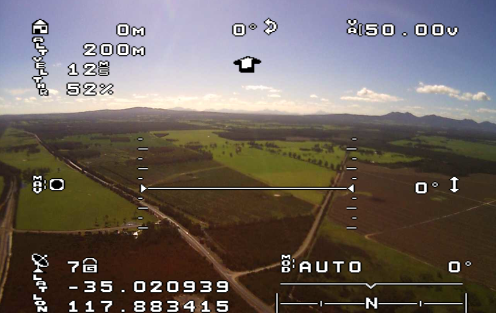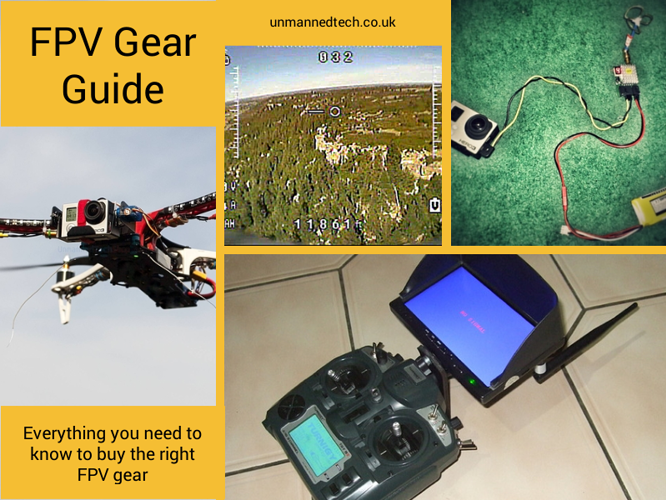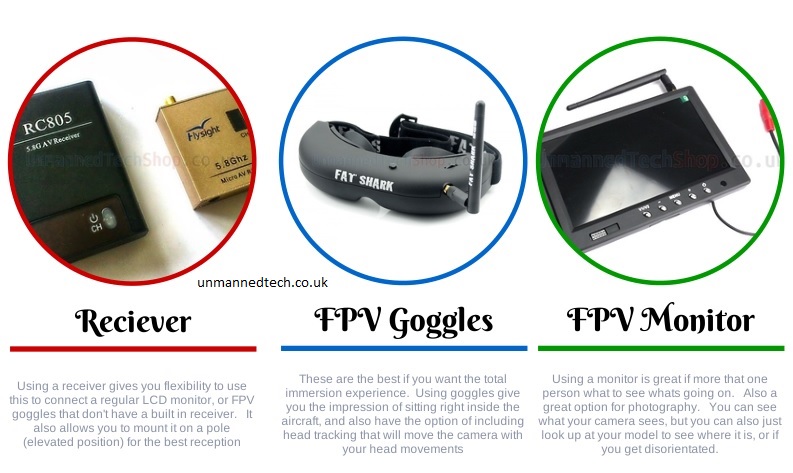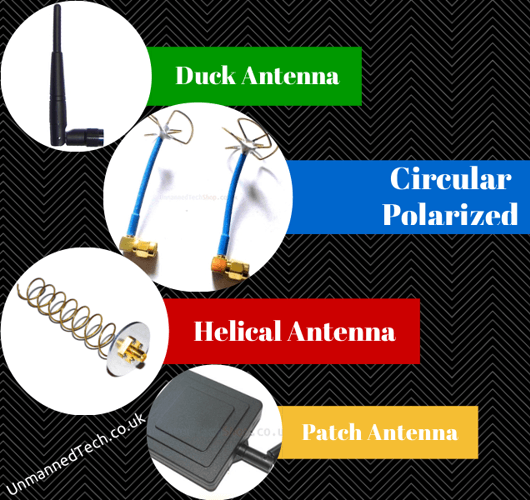If you would like to get into FPV (first person view), or simple have a way to send live video down to the ground from your quadcopter/aircraft, then this guide will show you some options. This is just a brief guide to give you a better idea about what to choose for your FPV system. If you are interested in a particular area, ask below, or simply search on the internet ![]()
Camera
There are two options here, you can use a dedicated FPV camera, and take a feed from you gopro/other camra.
Dedicated FPV camera
This is the best option if you are mainly flying FPV for the experience. Having a dedicated camera that is not on a gimbal will give you a better sense of motion. The other advantage is that FPV cameras are usualy cheaper, and much lighter than other cameras. If you are flying FPV for the experience/ fun of it and dont care about taking videos/photos then this is the best way to go. To find out more detilas check out our FPV camera guide along with some suggestions for great FPV cameras.
Feed from gopro (video out from camera)
This is best if you want to use the video feed to frame your photos/videos if you are shooting video/photos with your drone. Usually you will use a gimbal for such applications and because the camera is stabilized it can be difficult to judge the vehicle movement. However if you have a fixed camera (not so ideal for videos/photos) then it will be a fine to use your gopro/ other camera with video out
Transmitter
The transmitter is used to wirelessly send the video signal back to the ground. Due to regulations you will only be able to use a 5.8Ghz 25mw transmitter without any special licenses (here in the UK, and most of Europe). Otherwise if there are no restrictions in your country then you might want to use a transmitter with more power. Most of our transmitters operate on multiple frequencies and are compatible with many receivers, but before you buy one make sure that the transmitter and receiver both run on the same frequency channels in the 5.8Ghz band.
- 5.8GHz 25mw Transmitter (does not require license)
- 5.8Ghz 200mw Transmitter (requires license in certain countries)
Why use 5.8Ghz frequency?
There are many possible frequencies to use for FPV, with the lower frequencies having better signal (lower frequencies can pass through walls/trees easier. Due to regulations, we are only allowed to use 2.4Ghz, and 5.8ghz for aerial FPV. But 5.8Ghz is the most popular for FPV since 99% of us use 2.4Ghz for RC control.
Will more power give my more FPV range?
Short answer is not relay. The power of a transmitter follows and inverse square rule, so if you double the power, you will not get double the range. You will get abit more range with a powerful transmitter, but its always best to use a better antenna (see section on antennas), Using some of the powerful FPV transmitters tend to draw alot of power.
Receiver
Again there are a couple options for you to choose from in terms of FPV receivers.
Separate Receiver
The first option is to use a separate receiver and monitor. This is great if you have a LCD monitor/goggles and want to be flexible with your setup. Or perhaps if you want to use a USB capture card to view the video feed on your ground station laptop. It also lets you mount your receiver in the ideal position and run a cable to your goggles/monitor. This can be on a pole or similar to get the best possible reception.
Monitor/Goggles with Receiver built in
The other option is to use a monitor with a built in receiver, this is great as its a compact, easy to use system. Most monitors with receivers also have an extra video output so you can still use goggles while your friend can look at the monitor while spotting for you.
If you are flying for fun, and want to total immersion of FPV, then it would probably be best to go with FPV goggles with a built in receiver as its neat and tidy.
If you are using FPV for film/photography work a monitor is a great option as it lets you and others see what the camera sees, but gives you the option of still looking up at your aircraft while its flying
Diversity, what is it?
Simply, put a diversity receiver essentially has two (or more) receivers that work together to find which has the best signal. So at the end of the day this usually gets better reception as a single receiver as it allows you to use different antennas, or the same ones but at different positions. If you want the full details have a look at the Wikipedia page.
Antenna
Duck Antennas
Most FPV transmitters and receivers come with some duck antennas, they are not that great for FPV since they only get the best signal when the two antennas line up
Circular Polarized Antennas
Simply put these are the most popular for FPV because they give a good signal irrespective of the angles the antennas are at. This way they dont break up when you turn your aircraft. If you dont plan on flying at extreme distances these antennas would be the best option.
Helical/Patch Antennas
If you are doing some long range FPV (with permission from the local authority of course ![]() ) Patch, and helical antennas are great at picking up long range signals. The only problem with these is that they are directional, so you need to point them at your aircraft for them to pickup the signal. Usualy most people either have a friend to sit there and point at the aircraft as you fly, but the other option is to use a antenna tracker that does this automatically. I would only suggest you get into long range FPV once you are a more advanced FPV user as you dont want to loose your expensive gear to a silly mistake during your setup.
) Patch, and helical antennas are great at picking up long range signals. The only problem with these is that they are directional, so you need to point them at your aircraft for them to pickup the signal. Usualy most people either have a friend to sit there and point at the aircraft as you fly, but the other option is to use a antenna tracker that does this automatically. I would only suggest you get into long range FPV once you are a more advanced FPV user as you dont want to loose your expensive gear to a silly mistake during your setup.
Batteries/Power
There are two main options for powering your FPV gear. Powering direct from your flight battery, and using a separate battery just for your FPV gear.
Power Direct from your flight battery
This method is only suggested if you dont have the space or weight for to carry an extra FPV battery because usually the motors/ESC cause electrical noise which can degrade your video signal. Using things like a filtered power supply, or voltage regulator can reduce those effects.
Power using a separate battery
If you have the space, this is the best way to power your FPV gear, as it allows you to choose a battery at the correct voltage (2S usually) for your FPV gear. Because your FPV gear will be powered by a separate circuit it will be free from interference from your motors/ESC etc…
What size battery do I need?
If you are using a separate FPV battery, I would suggest something around the 500-1000mAh range. This will largely depend on the power requirements of your camera and transmitter, but unless you are using a high power Transmitter (500mW+) a 500mah battery should last a couple of flights per charge.
If you are using your flight battery then the main consideration is the voltage. Most FPV gear runs between 5-12V, so check your FPV gear, but in general you should always use a voltage regulator/filter for the FPV part of the circuit.
On Screen Display (OSD)
On screen display units (OSD) allow you to overlay some information onto your video stream which can be useful for some people. Information can include things like your altitude, heading, direction to home, distance from home (very useful so you dont fly too far away and loose signal!). Others prefer to have a clean view as the overlay can sometimes cause a distraction.

OSD modules
There are loads of OSD modules around on the market. Because the OSD dispalys sensor data, it will need some sensors to get readings from (like GPS for position/altitude). Most of them are designed to connect into your autopilot/flight controller and get the information from there which is great as you only need a single addon board for the OSD. Some autopilot also come bundled with OSD built in. Having the OSD connected to your autopilot is best for multirotors as its pointless having two of the same sensors (one for autopilot and one for OSD) which just adds extra weight to your quadcopter. The important thing to bear in mind when buying one is if its compatible with the autopilot you are using. For example a DJI OSD will not be compatible with an ardupilot based system.
All in one OSD
If you are flying fixed wing aircraft, its more common to use an all in one OSD module that includes the OSD module but also the required sensors like GPS, airspeed, voltage etc… Since fixed wing planes are much easier to fly you dont need a flight controller. However some all in one OSD units also have some basic autopilot features like return to home if you loose signal which prevents you from crashing or loosing your aircraft.
FY-41AP
This is a great autopilot with built in OSD, it has the best of both words as its a high quality autopilot with loads of feature that is very small and also has a nice OSD built in to overlay information onto your FPV video stream.
If you have any questions/comments, or I have missed something out please let me know!


